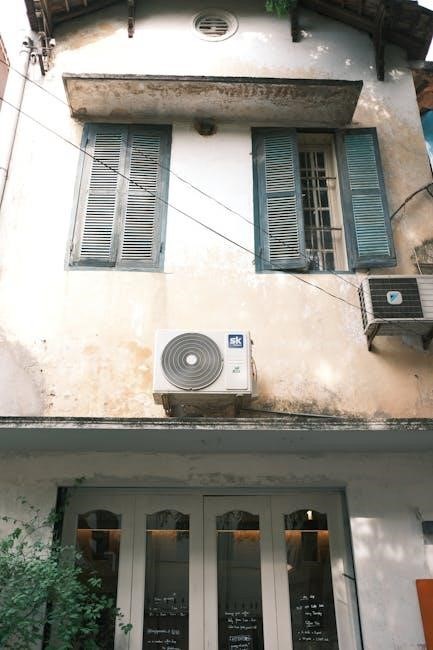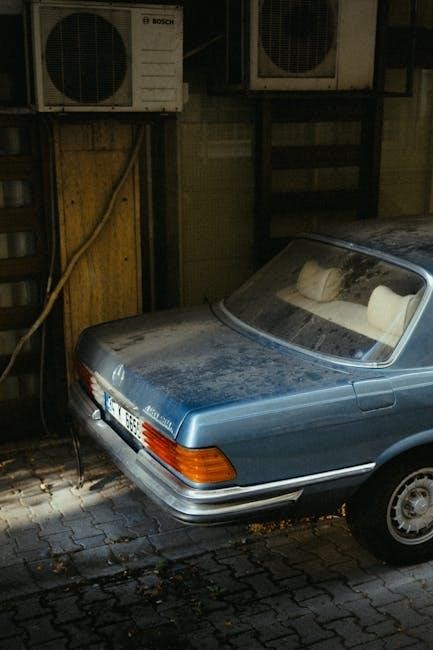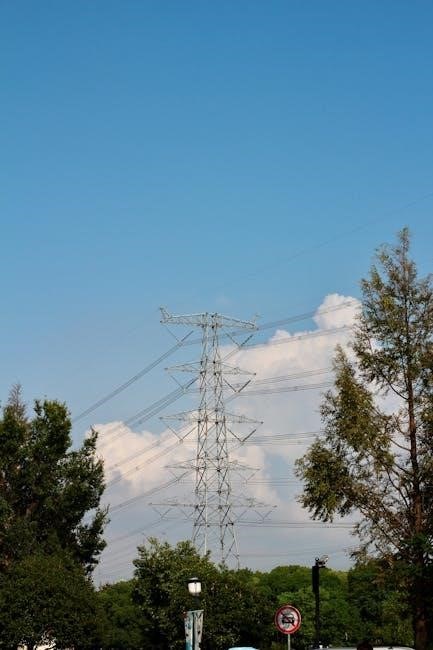Welcome to our comprehensive guide on Mitsubishi air conditioner troubleshooting. This guide helps homeowners diagnose and resolve common issues, ensuring optimal performance and extending unit lifespan. Safety first!
1.1 Overview of Mitsubishi Air Conditioners
Mitsubishi air conditioners are renowned for their innovative technology, energy efficiency, and reliability. With a wide range of models, including wall-mounted, ceiling-concealed, and ducted systems, they cater to various residential and commercial needs; Known for their inverter technology, Mitsubishi ACs provide consistent cooling with minimal energy consumption. They also feature advanced filtration systems, ensuring cleaner indoor air quality. Mitsubishi’s commitment to innovation and sustainability has made them a trusted brand worldwide. Their systems are designed for quiet operation, durability, and ease of use, making them a popular choice for modern spaces.
1.2 Importance of Regular Maintenance
Regular maintenance is crucial for ensuring the optimal performance and longevity of Mitsubishi air conditioners. Neglecting routine checks can lead to reduced efficiency, higher energy bills, and premature wear of components. Cleaning air filters, inspecting refrigerant levels, and ensuring proper drainage are essential tasks. Maintenance also helps prevent common issues like ice buildup, mold growth, and electrical faults. A well-maintained system operates more efficiently, saving energy and extending its lifespan. Additionally, regular maintenance ensures better indoor air quality and consistent cooling performance, making it a vital practice for homeowners and businesses alike. Always follow the manufacturer’s maintenance guidelines.
1.3 Common Issues and Solutions
Mitsubishi air conditioners, like any appliance, can encounter issues that affect performance. Common problems include the unit not turning on, improper cooling, or unusual noises. Many of these issues can be resolved with simple checks, such as ensuring the power is on, cleaning dirty filters, or checking for blocked vents. For cooling problems, low refrigerant levels or faulty thermostats may be the cause. Strange noises often result from loose parts or debris. Addressing these issues promptly can prevent more severe damage. Always refer to the user manual or error codes for guidance before attempting repairs. Regular checks can help avoid these issues altogether.

Common Mitsubishi Air Conditioner Problems
Mitsubishi air conditioners may face issues like power failures, cooling inefficiency, or unusual noises. These problems often arise from electrical faults, blocked filters, or refrigerant leaks.
2.1 The Unit is Not Turning On
If your Mitsubishi air conditioner fails to turn on, it could indicate a power supply issue. Check if the circuit breaker has tripped or a fuse has blown. Ensure the unit is properly plugged in and the outlet is functioning. Verify the remote control’s battery life or try using the control panel directly. If the thermostat is set incorrectly, the unit may not activate. Also, ensure there are no power outages in your area. If these steps don’t resolve the issue, it may signal a more serious electrical problem requiring professional attention. Always prioritize safety when troubleshooting electrical systems.
2.2 The Air Conditioner is Not Cooling Properly
If your Mitsubishi air conditioner isn’t cooling properly, check for low refrigerant levels, as this is a common cause. Ensure air filters are clean, as dirty filters restrict airflow and reduce efficiency. Verify thermostat settings to confirm it’s set to cool mode and the temperature is correctly adjusted. Inspect condenser coils for dirt or debris, as this can hinder heat dissipation. Also, ensure the unit is appropriately sized for the space. If issues persist, it may indicate a malfunctioning compressor or refrigerant leak, requiring professional assistance. Always maintain proper airflow and regular maintenance to optimize cooling performance.
2.3 Unusual Noises from the Unit
Unusual noises from your Mitsubishi air conditioner can indicate potential issues. Rattling sounds may suggest loose parts or debris inside the unit. Hissing or bubbling noises could signal a refrigerant leak, which requires immediate attention. Clunking or grinding noises often point to a malfunctioning compressor or fan motor. Vibrations or squealing sounds may indicate misaligned or worn-out belts or bearings. Regular maintenance, such as tightening loose components and replacing worn parts, can prevent or resolve these issues. If noises persist, it’s recommended to contact a professional to avoid further damage to the unit. Early detection ensures optimal performance and extends the unit’s lifespan.
2.4 Water Leaking from the Indoor Unit
Water leaking from the indoor unit is a common issue that can be caused by a clogged condensate drain line or a malfunctioning drain pump. If the drain line is blocked, water may accumulate and overflow from the unit. Additionally, improper installation or a damaged drain pan can lead to leaks. To resolve this, check the drainage system for blockages and ensure it’s properly connected. If the issue persists, inspect the drain pump for damage or malfunction. Regular maintenance, such as cleaning the drainage system, can help prevent water leaks and ensure smooth operation. Addressing this issue promptly prevents water damage and maintains efficiency.
2.5 Blinking Lights on the Unit
Blinking lights on a Mitsubishi air conditioner often indicate specific error codes or operational statuses. The pattern and frequency of the blinks correspond to particular issues, such as temperature sensor malfunctions or compressor problems. For example, two blinks may signal a thermistor issue, while three blinks could indicate a sensor failure. Refer to the user manual to decode the blinking patterns. If the issue persists after troubleshooting, resetting the unit or consulting a professional is recommended to avoid further complications. Addressing blinking lights promptly ensures optimal performance and prevents potential system damage. Regular checks can help identify issues early.

Troubleshooting Cooling Issues
Troubleshooting cooling issues in Mitsubishi air conditioners involves checking refrigerant levels, air filters, and thermostat settings. Ensure proper airflow and inspect for blockages or damage to components.
3.1 Low Refrigerant Levels
Low refrigerant levels are a common cause of cooling issues in Mitsubishi air conditioners. This occurs due to leaks in the refrigerant lines or improper installation. Symptoms include reduced cooling performance, hissing sounds, or ice buildup on the coils. If you suspect low refrigerant, turn off the unit immediately to prevent further damage. A professional HVAC technician must inspect and refill the refrigerant to the recommended levels. DIY refilling is not advised, as it requires specialized tools and knowledge. Regular maintenance can help identify leaks early, ensuring optimal cooling efficiency and system longevity.
3.2 Blocked or Dirty Air Filters
Blocked or dirty air filters can significantly reduce the performance of your Mitsubishi air conditioner. When filters are clogged with dust and debris, airflow is restricted, leading to poor cooling and increased energy consumption. This can also cause the system to work harder, potentially resulting in damage. Regularly cleaning or replacing the air filters every 1-3 months can prevent these issues. Proper maintenance ensures optimal airflow, energy efficiency, and overall system performance.

3.3 Faulty Thermostat Settings
Faulty thermostat settings can disrupt your Mitsubishi air conditioner’s performance. If the thermostat is not functioning correctly, the system may fail to cool properly or cycle on/off repeatedly. Ensure the thermostat is set to the correct mode (cooling) and temperature. Check for dead batteries or wiring issues if it’s a wireless model. Incorrect settings or a malfunctioning thermostat can lead to inefficient operation. Testing the thermostat by adjusting settings and observing system response can help identify issues. Proper calibration and functionality are essential for maintaining consistent cooling and energy efficiency;
3.4 Malfunctioning Compressor or Condenser
A malfunctioning compressor or condenser can severely impact your Mitsubishi air conditioner’s cooling performance. The compressor, acting as the system’s heart, pumps refrigerant, while the condenser cools the hot refrigerant gas. If the compressor fails, the system may not turn on or may produce unusual noises like clunking or grinding. A faulty condenser, often located outside, may be dirty or blocked, hindering its ability to cool the refrigerant effectively. Low refrigerant levels or a faulty capacitor can also cause compressor issues. Cleaning the condenser, checking refrigerant levels, or replacing the capacitor may resolve the problem. If these steps fail, professional assistance may be necessary to repair or replace these critical components.
Error Codes and Their Solutions
Mitsubishi ACs use error codes to signal issues, aiding quick diagnosis. Codes like 5101 and 5102 indicate sensor or thermistor problems. Resetting or cleaning filters may resolve them; persistent codes need professional help.
4.1 Understanding Mitsubishi Error Codes
Mitsubishi air conditioners use specific error codes to indicate system issues, helping users and technicians identify problems quickly. These codes, displayed on the unit or remote, correspond to specific faults, such as sensor malfunctions or refrigerant issues. Understanding these codes is essential for effective troubleshooting. They are designed to provide clear guidance, enabling users to address minor issues independently or seek professional assistance when needed. Familiarizing yourself with Mitsubishi’s error code system can save time and prevent further damage to the unit. Always refer to the user manual or official resources for accurate code interpretations.
4.2 Common Error Codes (e.g., 5101, 5102, 5110)
Mitsubishi air conditioners often display specific error codes to indicate system malfunctions. Code 5101 typically signifies communication issues between the indoor and outdoor units; Code 5102 may point to high-pressure errors, often due to refrigerant level imbalances. Code 5110 usually indicates a problem with the indoor unit’s temperature sensor. These codes are designed to help users and technicians quickly identify and address issues. Regularly checking and understanding these codes can prevent further damage and ensure optimal performance. Refer to the user manual or contact a professional for precise solutions tailored to your unit.
4.3 How to Reset Error Codes
Resetting error codes on a Mitsubishi air conditioner can often resolve minor issues. Start by turning off the unit and unplugging it from the power source. Wait for 10-15 minutes to allow the system to reset. Plug it back in and turn it on to see if the error code disappears. If the code persists, check the circuit breaker or ensure proper installation. For some models, resetting can be done via the remote control by pressing specific buttons. Always refer to the user manual for model-specific instructions. If the issue remains, contact a certified technician to avoid further complications.

Electrical and Power-Related Issues
Identify issues like tripped circuit breakers, faulty wiring, or damaged sensors. Ensure proper power supply and check for loose connections. Consult a professional if problems persist.
5.1 Power Outages or Tripped Circuit Breakers
A power outage or tripped circuit breaker can stop your Mitsubishi AC from functioning. First, check the circuit breaker or fuse box to ensure the breaker hasn’t tripped. If it has, reset it and test the unit. If the issue persists, verify the power supply to the AC. Electrical surges or overloaded circuits may also cause the problem. Ensure no other high-power appliances are connected to the same circuit. If the breaker trips again, consult a licensed electrician to inspect the wiring. Resetting the AC after a power outage may also resolve the issue temporarily.
5.2 Faulty Remote Control or Sensors
A faulty remote control or malfunctioning sensors can disrupt your Mitsubishi AC’s operation. Check the remote’s batteries first; replace them if necessary. Ensure the remote’s signal is unobstructed and within range. Clean the infrared sensor on the AC unit to ensure proper communication. If issues persist, test the remote’s functionality or try using the control panel directly. Sensors like temperature or motion detectors may also malfunction, causing incorrect readings. If the problem isn’t resolved, resetting the unit or consulting the user manual may help. For persistent issues, contact a professional to diagnose sensor failures or replace the remote.
5.3 Electrical Component Failures
Electrical component failures can cause significant disruptions to your Mitsubishi AC’s operation. Common issues include faulty capacitors, blown fuses, or damaged circuit boards. Symptoms may include the unit not turning on, intermittent operation, or tripped circuit breakers. Always switch off power before inspecting internal components. Check for visible signs of damage, such as burnt wires or swelling in capacitors. If you identify a failed component, replace it with an original Mitsubishi part. For complex electrical issues, avoid DIY repairs and contact a licensed technician to ensure safety and proper functionality. Regular inspections can help prevent such failures.

Drainage and Water-Related Problems
Mitsubishi ACs may face drainage issues like clogged systems, water leaks, or damaged drain pumps. Regularly inspect and clean the drain to prevent water damage or mold growth.
6.1 Clogged Drainage System
A clogged drainage system is a common issue in Mitsubishi air conditioners, often caused by dirt, mold, or debris buildup in the drain hose or pan. This blockage can lead to water leaks, reduced cooling efficiency, and even system shutdown. To resolve this, turn off the AC, locate the drain hose, and inspect for blockages. Use a soft brush or wet/dry vacuum to clean the hose and drain pan. If the clog persists, check for kinks or bends in the hose and straighten them. Regularly cleaning the drainage system can prevent such issues and ensure proper water flow. Always ensure the drain is clear to maintain optimal performance and avoid water damage. If unsure, consult a professional for assistance. Regular maintenance is key to preventing clogs and ensuring the system runs smoothly.
6.2 Damaged Drain Pump or Sensor
A damaged drain pump or sensor can disrupt proper water drainage in your Mitsubishi air conditioner, leading to water accumulation or leaks. The drain pump may fail due to wear and tear, power issues, or blockages. Similarly, the sensor might malfunction, incorrectly detecting water levels. To address this, inspect the pump for damage or blockages and ensure it has power. Clean or replace the pump if necessary. For the sensor, check its electrical connections and test its functionality using a multimeter. If the sensor is faulty, replace it with a compatible part. Regular maintenance can help prevent such issues. If problems persist, consult a professional for assistance.
6.3 Water Leaks from the Outdoor Unit
Water leaks from the outdoor unit of your Mitsubishi air conditioner can occur due to issues like refrigerant leaks, condenser coil damage, or a blocked drainage system. Inspect the unit for visible damage or corrosion. Check the refrigerant lines for leaks, as this can cause water to escape. Ensure the condenser coil is clean and free of debris, as blockages can disrupt proper water flow. If the issue persists, inspect the drain system for blockages or damage. Regular maintenance, such as cleaning the condenser and checking drainage, can help prevent leaks. If the problem is severe, contact a professional to address it effectively.

Noise and Vibration Issues

Noise and vibration issues in Mitsubishi ACs often stem from loose parts, misaligned fans, or worn-out components. Regular maintenance can help prevent and address these problems effectively.
7.1 Loud Noises from the Indoor Unit
Loud noises from the indoor unit can be caused by loose screws, debris accumulation, or a faulty fan motor. Check for loose parts and tighten screws if necessary. Clean the fan blades and filters regularly to ensure smooth operation. If the noise persists, it may indicate a malfunctioning motor or bearings, which require professional attention. Ignoring these issues can lead to further damage or system failure. Addressing the problem promptly ensures optimal performance and minimizes potential repair costs.
7.2 Vibrations from the Outdoor Unit
Vibrations from the outdoor unit can be caused by improper installation, loose mounting screws, or an imbalanced fan. Ensure the unit is level and securely fastened to its base. Check for loose screws and tighten them if necessary. If vibrations persist, inspect the fan blades for damage or debris. An uneven surface or a faulty compressor could also contribute to the issue. Addressing vibrations promptly prevents damage to internal components and ensures quiet operation. If self-troubleshooting fails, consult a professional to assess and correct the problem effectively.
7.3 Loose Parts Causing Noise
Loose internal or external components can cause noise in Mitsubishi air conditioners. Check the fan blades, motor mounts, and casing screws for tightness. Vibrations during operation may loosen these parts over time. Use a screwdriver to tighten any loose screws or bolts. Ensure the fan is properly aligned and balanced. If the noise persists, inspect for worn-out rubber mounts or gaskets, which can be replaced. Addressing loose parts promptly prevents further damage and maintains efficient operation. If unsure, consult a professional to identify and secure all components effectively.

Advanced Troubleshooting Steps
Advanced troubleshooting involves checking refrigerant levels, inspecting inverters, and testing sensors. Use specialized tools to identify leaks or component failures. Professional assistance may be required for complex issues.
8.1 Checking for Refrigerant Leaks
Refrigerant leaks can significantly reduce cooling performance. To check for leaks, use an electronic leak detector or a UV dye kit. Turn the AC off and inject the dye into the refrigerant system. Run the unit for 15-30 minutes to allow the dye to circulate. Use a UV light to inspect for bright yellow traces, indicating leaks. Common areas to check include connections, valves, and coils. If a leak is found, turn off the system and contact a professional to repair and recharge the refrigerant. Always follow safety guidelines when handling refrigerants.
8.2 Inspecting the Inverter and Capacitor
The inverter and capacitor are crucial for efficient operation. Begin by turning off the power and accessing the internal components. Visually inspect the inverter for signs of damage, such as burn marks or swelling. Check the capacitor for swelling, leaking fluid, or corrosion. Use a multimeter to test for continuity and proper voltage levels. If any issues are found, replace the faulty parts immediately. Ensure all connections are secure to prevent electrical arcing. If unsure, consult a professional to avoid further damage or safety risks. Proper inspection ensures optimal performance and prevents system shutdowns.
8.3 Testing the Thermostat and Sensors
Testing the thermostat and sensors is essential for ensuring proper Mitsubishi air conditioner operation. Start by verifying the thermostat’s accuracy using an independent thermometer. Compare the displayed temperature with the actual room temperature. If there’s a discrepancy, recalibrate the thermostat according to the manufacturer’s instructions. Next, inspect the sensors for dirt or debris, which can affect accuracy. Clean them gently with a soft brush or compressed air. Use a multimeter to check sensor voltage and resistance, ensuring they send correct signals to the control board. If communication issues arise between the thermostat and AC unit, reset or recalibrate the system. Addressing these issues ensures efficient cooling and system reliability.

When to Call a Professional
Call a professional when facing major component failures, complex electrical issues, or persistent problems after DIY fixes. Experts ensure safety and proper system restoration.
9.1 Major Component Failures
Major component failures, such as a faulty compressor, broken PCB, or damaged inverter, require professional intervention. These critical parts are essential for the AC’s operation and often cannot be repaired without specialized tools and expertise. Attempting DIY fixes on such components can lead to further damage or safety hazards. A certified technician will diagnose the issue accurately and replace or repair the components using genuine Mitsubishi parts, ensuring the system operates safely and efficiently. Major failures are not to be underestimated, as they can render the system inoperable if not addressed properly. Professional service is indispensable in such cases.
9.2 Complex Electrical Issues
Complex electrical issues, such as faulty wiring, short circuits, or malfunctioning PCBs, require professional expertise. These problems often stem from internal electrical components and can be hazardous to address without proper training. Improper handling of electrical systems can lead to safety risks or further damage. A certified technician will diagnose the issue using specialized tools and repair or replace faulty components. DIY attempts may worsen the problem or void the warranty. Electrical issues are critical and should only be handled by qualified professionals to ensure safety and system reliability. Prompt professional attention is essential to prevent prolonged downtime or escalating damage.
9.3 Persistent Problems After DIY Fixes
If issues with your Mitsubishi air conditioner persist despite DIY attempts, it may indicate a deeper problem requiring professional attention. Persistent issues could stem from underlying faults that basic troubleshooting cannot resolve. Repeated DIY fixes might also cause further damage or mask symptoms without addressing the root cause. In such cases, hiring a certified technician ensures proper diagnosis and repair. They possess the tools and expertise to identify and resolve complex issues that DIY methods cannot handle. Persistent problems often signal the need for specialized knowledge and equipment to restore optimal performance safely and effectively.

